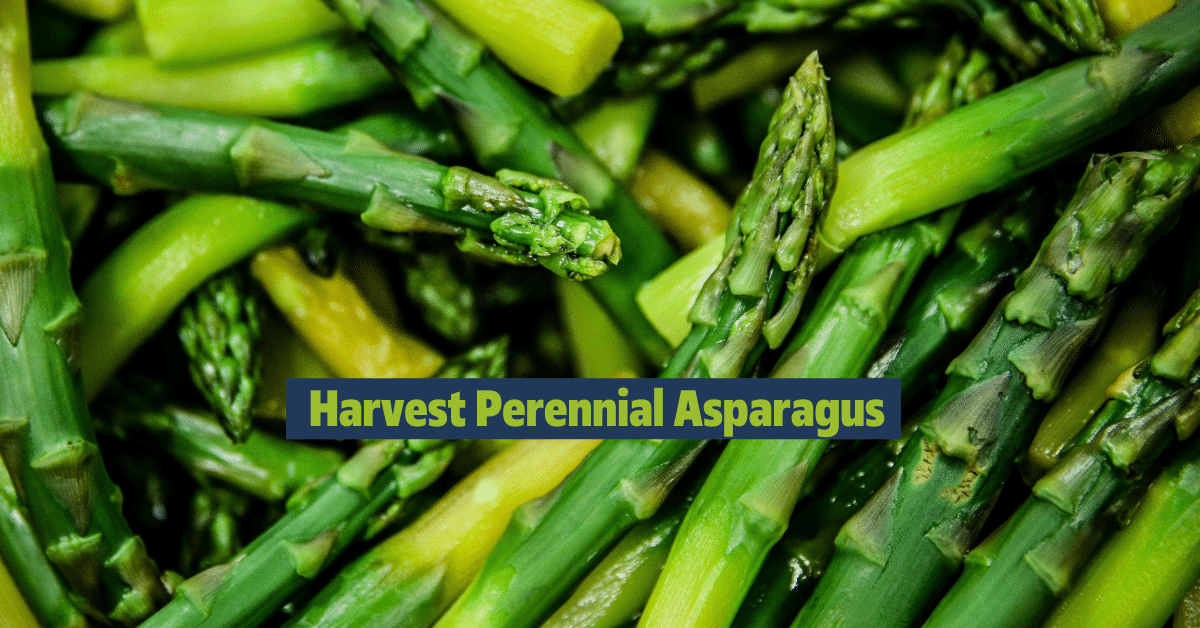Introduction to Harvest Perennial Asparagus
Plant, Grow, & amp Harvest Perennial Asparagus, is one of the primary plants that welcome us in springtime! It’s perpetual, which implies that the light lances will return a seemingly endless amount of time after year once it gets set up. What’s more, its ferny foliage makes a magnificent decorative. Here are how to Plant, Grow & Harvest Perennial Asparagus from planting through reap!
The main thing to think about perennial asparagus is that you definitely should not read it during the few seasons. These asparagus plants should be permitted to get set up before you can collect reasonably. However, the persistence is justified as asparagus beds can be beneficial for 15, 20, now, and then as long as 30 years.
Table Of Content
An overview of Perennial Asparagus
Biological Name
Asparagus officinalis
Plant Type
Perennial vegetable
Maturity Period
7-14 days
Maturity Size
5 feet tall, 3 feet wide
Soil Type
Sandy, Loamy
Soil pH
Acidic to neutral (6.0 to 7.0)
Exposure
Full Sun
Hardiness (USDA Zone)
4 to 9
Spacing
12 inches wide by 12 inches deep
Bloom Time
Spring, summer, fall, winter
Toxicity
Non-toxic
Flower Color
Pale yellow, greenish
Growth Rate
21 days
Native Zone
Europe, Africa
Maintenance
Asparagus ought not to have its foundations upset, so you’ll have to tenderly hand-pull weeds, taking into consideration not to upset asparagus’ underlying foundations. Weeds will turn out to be less of an issue as the plants fill in. Mulch around the plant with manure or grass clippings to help hold soil dampness and lessen weed development.
Before you feel free to plant your asparagus, consider the amount, you need. Each plant produces around a one-half pound of lances. Additionally, remember that in the initial two years of development, asparagus is not consumable! Reap lances in the third year of development, when the plant is set up.
Growing of Harvest Perennial Asparagus in pots
- Plant asparagus in the spring.
- Set up a pot or compartment in any event 20 inches down and 20 crawls in width.
- Be sure that your pot or compartment has seepage openings. If not, drill some waste openings at the lower part of the compartment to guarantee significant seepage.
- For best outcomes, utilize a plastic pot rather than an earthen pot, as plastic pots don’t retain as much dampness, in addition to its simpler to make seepage openings.
- If there is a lot of dampness, your asparagus plant could get a parasitic infection.
- Add around two crawls of rock to the lower part of the pot. The rock helps the Perennial asparagus from getting a lot of dampness and hence forestalling decay and illness.
- Mostly fill the pot with a nursery blend soil.
- Dive an opening in the focal point of the dirt to a profundity of around 8 inches and around multiple times the width of an asparagus crown.
- This will give a lot of room for the asparagus root framework to fan out.
- Spot a spoonful of matured fertilizer in the focal point of the opening.
- Presently place asparagus‘ foundations in the opening and spread them out with your hands.
- Cover the crown with around two crawls of soil.
- Water the asparagus following planting.
- Keep the dirt clammy as the asparagus crown develops.
- When shoots begin showing up on the crown, step by step covers them with soil, leaving about a large portion of an inch of the shoots revealed.
- Keep covering the shoots every week until they arrive at the highest point of the dirt level.
- You ought to get around 6-12 shoots from every asparagus crown, contingent upon the assortment you’ve planted.
Growing of Harvest Perennial Asparagus in Ontario
Asparagus is generally developed from 1-year-old plants called “crowns,” however, it can likewise be developed from seed. Nonetheless, beginning with asparagus crowns kills the time of drawn-out weeding that accompanies beginning from seed and will accelerate creation by and large.
For example, a couple of assortments, open-pollinated ‘Purple Passion’ and crossbreed ‘Sweet Purple,’ can be developed from seed. Start seeds inside in spring and set out the seedlings when 12 to 14 weeks old, soon after your last spring ice.
Absorb asparagus seeds water for as long as 24 hours before planting.
Plant seeds in wet peat or seed-beginning soil in pads or peat cups.
When plants arrive at 12 creeps in stature, solidify them off outside for seven days.
After the previous spring ice, relocate the young plants to a brief nursery bed. When they develop in the fall, distinguish the berry-less male asparagus plants and relocate them to your perpetual planting site, eliminating the less-gainful female plants.
Growing of Harvest Perennial Asparagus In Raised Beds
The advantage of preparing your asparagus bed is that you can undoubtedly control many of the conditions that asparagus plants like and make the support of your bed over the long haul simple to stay aware of. Asparagus can be begun from seed. However, it is most usually planted in the nursery as crowns that are two years of age and have long roots.
- The asparagus plant needs an ideal opportunity to set up its foundations. When beginning from seed, permit three seasons to pass before you collect any lances.
- You can reap asparagus lances inside the initial two years on the off chance that you plant crowns.
- Whenever they are planted, keep your asparagus plants watered with around 1 inch of water each week.
- You could set up a trickle water system, a soaker hose, or even utilize covered mud pots to make watering more advantageous.
- This will be considerably simpler in a tall raised bed because you will not need to twist around!
- Try not to squander space! Asparagus detests root rivalry. You can utilize the space between your plants to develop shallow established yields like spinach and lettuce.
The asparagus fronds will conceal the mixed greens and shield them from a lot of suns. Likewise, you can develop spices like basil and parsley, or marigolds and tomatoes, which help repulse asparagus bugs.
FAQ
How to trim asparagus?
The ideal approach to manage asparagus is the most obvious way: with a gourmet expert’s blade and cutting board. Line up the entirety of the lances in succession and cut off the closures at the same time. It will help if you cut right where the stalks go from white into the green.
How to cut asparagus?
There are several ways by which you can cut asparagus. We have listed three ways that help you to cut asparagus in your kitchen:
Trimming the end
Cutting the spears directly
Chopping asparagus
How to harvest asparagus?
Try not to reap any asparagus lances during the initial two years that plants are in the perpetual bed since they need to place energy into building up profound roots.During the third season, pick the lances over four weeks, and by the fourth year, stretch out your collection to about two months.
In late winter, reap sticks each third day or thereabouts; as the climate warms, you may need to pick your asparagus two times per day to stay aware of creation.
How long asparagus good for?
If appropriately put away, asparagus will typically save well for around 3 to 5 days in the fridge.
What happens if you eat asparagus daily?
As a decent wellspring of fiber, asparagus advances routineness and stomach-related wellbeing and may help lessen your danger of coronary illness, hypertension, and diabetes.
Growing asparagus from seeds?
It’s suggested that you start asparagus seeds inside or in a nursery from mid-February to May under splendid lighting. Soil temperatures for seed germination should be somewhere in the range of 70 and 85 degrees F. (21-29 C.). Drench the seeds for several hours. At that point, plant each seed ½ inch (1 cm.)
Stages of growing asparagus?
Developing Asparagus from Crowns. b) Growing asparagus from Seeds.Site and Soil.
Planning Site for Plant Asparagus.
Planting. a. When to plant. …
Occasional Care. a. focusing on asparagus during spring. …
Reaping Asparagus.
Engendering Asparagus.
Taking care of Asparagus Problems.
When to plant asparagus?
Plant asparagus crowns (torpid underlying foundations of 1-year-old plants) in spring at about a similar time you would plant potatoes, yet don’t hurry to plant them if your diet is as yet cold. For example, a couple of assortments, open-pollinated ‘Purple Passion’ and mixture ‘Sweet Purple,’ can be developed from seed.

